
|
The B-HLD20 Battery Holder For the Olympus C-5060WZ and C-7070WZ |

| My other pages related to the Olympus C-5050Z, C-5060WZ, and X-7070WZ |
|
This accessory serves a dual purpose. First, it provides housing for two BLM-1 batteries, the same type as used directly by the camera. This should lead to twice the battery lifetime, measured in terms of pictures taken.
Second, the holder can be used as a grip for shooting in the vertical frame orientation. For this, it has an extra shutter release button, together with a zoom control lever. Additionally, it also has a wired remote control socket, working with the Olympus RM-CB1 cable release. This is the first such accessory for any compact camera (correct me if I'm wrong), and that is why I had to see it. Here are my impressions and comments. |
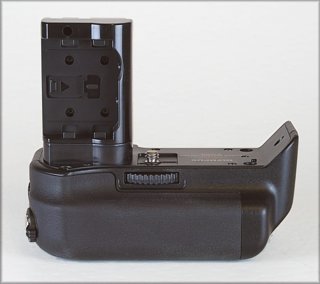
| |
|
Look and feel, make and finish The B-HLD20 is made of what looks like high-impact plastic, matching the external finish of the camera. The match is very good, and the quality of finish leaves nothing to be desired. The protruding bottom part (used as a hand grip in vertical shooting) has a rubberized front surface matching the grip on the '5060/7070. Overall, a very good impression. Mounting on camera This is done by tightening a screw which goes into camera's tripod socket. The door of camera's battery compartment has to be first removed (a tricky job, as it is done entirely by force; I wonder when my door hinges break off if I do it more often). It can be stored in a slot in the vertical protrusion on the holder, which goes into the battery compartment. The alignment is provided not only by that protrusion, but also by four small indentations on the holder, accepting the small rubber feet on the bottom of the camera. The arrangement seems secure enough, and B-HLD20 has its own tripod socket at the bottom, so that the whole ensemble can be used with a tripod as if nothing happened. The electric contacts for the release and zoom signal transfer to the camera body are provided as five wire pins sticking out of the holder base just behind the dummy vertical part (therefore not visible in the top picture); the corresponding receptacles on the body are hidden below the battery chamber hinge; you will not see them until the chamber door is removed. | ||
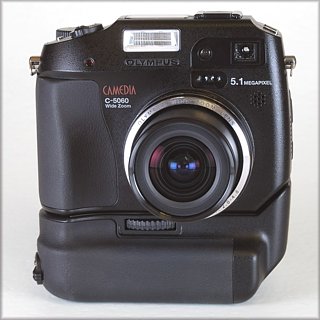
|
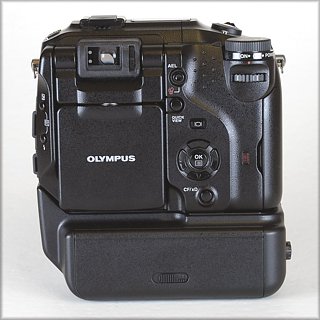
| |
|
Size and weight The plastic construction makes an empty B-HLD20 quite lightweight (just 135g). This, of course, changes, when the batteries are inserted. | ||
| It is, however, quite large, adding 40 mm (or about 50%) to the height of the camera. The depth is also considerable, as it has to accommodate the length of inserted batteries. |
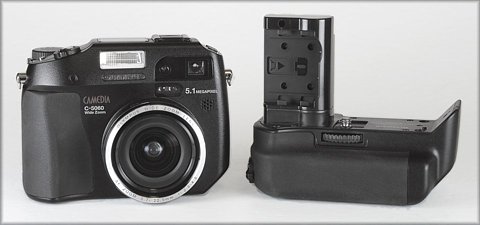
| |
|
Carrying the holder separately in your gadget bag seems to be out of question (and not just for this reason): you either mount it semi-permanently on the camera and leave it there, or not. | ||
|
Controls The right side of the B-HLD20 contains an extra shutter release, used in the vertical position, the shutter release lock, and wired remote socket. | |
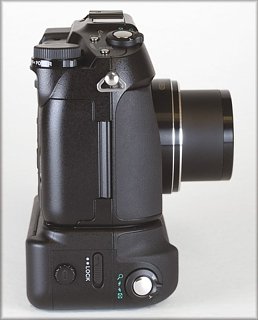
|
The shutter release looks and works exactly like the one on the camera itself. It also has the lever for changing the zoom setting. A sliding switch can be used to disable the shutter release, to avoid accidental use. The remote socket is like the one on the E-10 and E-20, accepting the wired RM-CB1 cable release. The three-pronged plug is quite cumbersome to match, but I'm glad Olympus kept the old remote usable with the new camera, otherwise it would have meant another $60 expense. My major gripe about the remote socket is the tiny, screw-on cap protecting it from elements. As soon as you remove it, it jumps off your hand, hiding somewhere in the grass, impossible to find. |
|
Besides, not including the remote socket on the camera itself is a questionable decision. It should be there to start with: having to buy the battery holder just to use a remote control is just wrong. Batteries As I already mentioned, the B-HLD20 has room for two lithium-ion BLM-1 batteries, or their non-Olympus equivalents. These are inserted through a hinged, spring-loaded door in the back of the holder, protected with a sliding lock. The compartment is accessible when the holder is attached to the camera and/or tripod. The battery chamber also has a small extra: a slot to store a spare xD-Picture card. This is, however, not very useful: the card is difficult to remove with both batteries in place. You do not have to load both batteries: everything will work just fine with just one. This is an important plus, as you can charge one battery at a time, while the other one keeps the settings in camera's memory from being lost. Otherwise the process of battery charging would have been much more cumbersome (or you would need four batteries, which are not cheap). The batteries are most probably connected in parallel; the other alternative, a sensor switching from one to another, would be more costly and difficult to implement (this is just a theoretical possibility; I have yet to see such a solution anywhere). This means that in a two-battery setup both batteries discharge approximately evenly. Also, if one dies for any reason, the other one will usually keep working. (Still, you will not be able to get a replacement in a local general store.) Anyway, what you get is 3000 mAh at 7.2V, plenty of juice to keep your camera going for a good few days (a nominal equivalent of 4600 mAh at the four-AA NiMH voltage), and that in addition to the low self-discharge rate of Li-Ion chemistry. | |
|
Documentation The multi-language instruction sheet (mine was in English, Spanish, German, and French) is in the best tradition of Olympus: it warns you against feeding batteries to babies (which is the first thing any camera user thinks of, just after opening the carton), but it does not contain a single piece of information which even a semi-literate user would not figure out on his own. Almost half of the printed text are warnings of moronic nature, most probably inserted upon insistence of corporate lawyers. For your entertainment, let me quote just two pieces: "Do not shake this product when a battery is attached. The battery could pop out and cause injury." Remember this before jumping with your '7070 into a conga line. "If the power battery holder falls off, it may be damaged or cause injury." There is no warning against dropping the holder while attached to the camera; this, when done from the top of a tall building, could be quite harmful. I'm not blaming Olympus for this; all manufacturers are doing it nowadays, especially on the US market. This just shows the stupidity of our court system, assuming that idiots, who otherwise would be disposing of batteries in their fireplaces, start from reading the fine print, and so lives are saved. What about not placing batteries in body orifices? Anyway, some meaningful technical information in the instruction sheet would be good. In the field: feel and handling The added bulk of the B-HLD20 does not affect the camera balance adversely. More, when standing on a flat surface, the camera now feels more stable, due to larger footprint and lowered center of mass. You will also clearly notice the increase in the total weight. Some people will find this objectionable, some will not. For me, the handling of the older C-5050Z is exactly what I expect from a compact camera; even the '5060 alone is already a little too bulky, not to mention the battery holder. Now, good news and bad news about handling. The good news is that, indeed, shooting verticals becomes easier, especially if you don't mean the extra weight. The grip may be somewhat too large for my taste, and it could possibly have been improved by a larger protrusion on the front, plus sculpted and rubberized surface on the back (where your thumb rests), but still, I consider the verticals easier now than with the camera alone. Your right arm does not have to be raised as high as before. The bad news is that shooting horizontally-oriented images is now nowhere as convenient as without the grip. Without it, the bottom-right corner of the camera rests in your palm naturally; now the holder prevents it from that, and your fingers have to grasp the camera harder, creating extra friction to prevent it from falling off. And this, for me at least, is the decisive factor against using this, otherwise very nice, accessory. The bottom line The B-HLD20 battery grip/holder is well-built, nicely finished, and works as advertised. Still, I wouldn't recommend its purchase to most of the users of the C-5060WZ. It is not cheap (expect a street price of $100 or so), and the gains, if any, are not in proportion to the expense.
If, despite what I just said, you still decide to get the B-HLD20, and you are willing to face the horizontals blues, you should not be disappointed. Did I mention that the thing is really nicely made and works just fine? | |

| My other pages related to the Olympus C-5050Z, C-5060WZ, and X-7070WZ |
| Home: wrotniak.net | Search this site | Change font size |
| Posted 2004/03/18; last updated 2005/09/06 | Copyright © 2004-2005 by J. Andrzej Wrotniak |